Refreshing a bedroom can make all the difference in transforming a home into a more inviting and restful space. Whether you’re working on a primary bedroom, guest bedroom, or small bedroom, the right bedroom ideas can enhance the overall aesthetic and functionality.
In this 7-minute read, we’ll explore practical and stylish bedroom design ideas that cater to various client needs and preferences.
From focal points to lighting and furniture styles, discover how to create stunning bedroom interiors that impress your clients and elevate their living spaces.
Let’s start with expert tips for understanding your clients’ needs.
How Do Your Clients Use Their Bedroom Space?
Understanding how your clients use their bedroom space is crucial for designing a room that meets their own bedroom needs and preferences. Here are some expert tips to guide you through the planning stages of a bedroom design or remodel project:
- Lifestyle Considerations: Start by discussing your clients’ daily routines and lifestyle. Are they early risers who need plenty of natural light or do they work night shifts and require a darker, more peaceful space during the day? Understanding their habits will help you design a room that enhances their well-being.
- Functional Needs: Determine the primary functions of the bedroom. Is it solely for sleeping or does it also need to serve as a home office, a reading nook or a dressing area? Each function influences the layout and furniture choices. For example, if they need an office nook, you’ll need to incorporate a desk and adequate lighting.
- Aesthetic Preferences: Discuss your clients’ style preferences. Do they lean towards modern, rustic, coastal or a mix of styles? Knowing their tastes will help you select colors, materials and furniture they’ll love. For instance, a client who loves the coastal style might appreciate a soft pink palette with natural wood elements.
- Storage Requirements: Address the need for storage. A clutter-free bedroom contributes to a more restful space, especially if it’s a small bedroom. Ask about their storage needs for clothing, linens and other items. Built-in closets, dressers and bedside tables with storage can be excellent solutions.
- Special Features: Identify any special features your clients want to include. Do they dream of a canopy bed, exposed beams or a fireplace? Incorporating these elements makes the primary bedroom feel more personalized and luxurious.
Key Considerations for Client Consultations:
- Ask about their daily routine and sleep patterns.
- Inquire about any multifunctional uses for the bedroom (e.g., office nook, reading corner).
- Discuss their favorite colors and decor styles.
- Identify specific storage needs (e.g., extra closet space, built-in shelves).
- Consider any desired special features (e.g., canopy bed, fireplace).
By asking the right questions and understanding exactly how your clients will use their bedroom you can come up with bedroom ideas that are both functional and aesthetically pleasing.
Head on to the next section to check out some of the top bedroom design ideas that work for just about any client.
10 Bedroom Design Ideas for Any Client
Whether you’re working with a small bedroom or a spacious primary bedroom, these ten versatile design ideas help you create stylish and functional interiors that cater to any client’s needs.
1. Choose a Focal Point
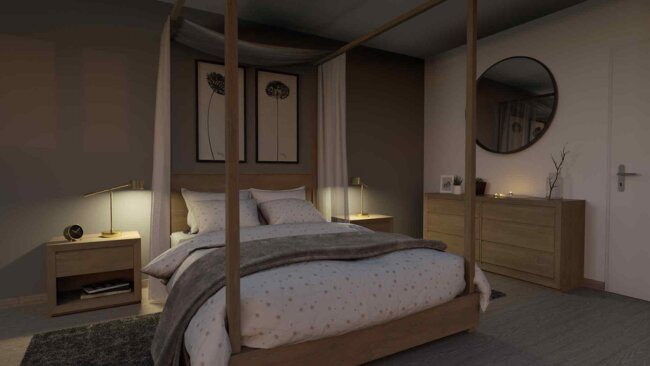
Design Explanation: Choosing a focal point is an essential aspect of bedroom design. A focal point draws the eye and anchors the room to provide a central piece around which the rest of the design can revolve. The focal point could be a statement headboard, an eye-catching piece of artwork or even a beautifully designed bed.
Why It’s a Good Idea: Creating a focal point in a bedroom is beneficial for several reasons:
- Enhances Visual Interest: A well-chosen focal point adds depth and intrigue to the room.
- Creates a Design Anchor: It provides a central element around which the rest of the room’s decor can be organized. This ensures a cohesive look.
- Personalizes the Space: A unique focal point, such as custom artwork or an antique headboard, can reflect your client’s personal style and taste.
Tips for Implementing in Your Design: When incorporating a focal point into your bedroom design, consider the following tips:
- Statement Headboards: Use a bold, upholstered headboard or a unique design to draw attention to the bed.
- Art Pieces: Position a large piece of artwork above the bed or on the main wall to create an eye-catching display.
- Canopy Beds: For a touch of luxury, choose a canopy bed with elegant drapery.
- Accent Walls: Paint or wallpaper the wall behind the bed in a contrasting color or pattern to make it stand out.
- Furniture Arrangement: Arrange the furniture to highlight the focal point.
2. Layer Lighting
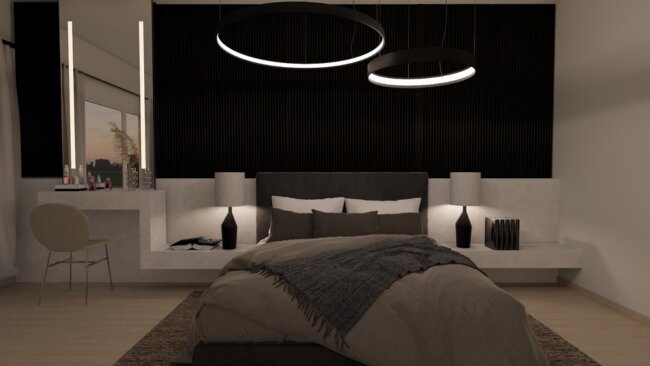
Design Explanation: Layering lighting in a bedroom involves using multiple light sources at different levels. This design idea includes ambient lighting (general lighting for the room), task lighting (focused lighting for specific activities like reading), and accent lighting (decorative lighting to highlight features).
Why It’s a Good Idea: Layering lighting offers several benefits that improve the bedroom design:
- Creates Ambiance: Different lighting layers allow you to adjust the mood and atmosphere of the room, from bright and energizing to soft and relaxing.
- Increases Functionality: Task lighting ensures that specific areas are well-lit for activities like reading or working.
- Adds Depth and Visual Interest: The right lighting can make all the difference in giving the room a modern, polished look. It helps architectural features, artwork and textured walls really stand out!
Tips for Implementing in Your Design: To effectively layer lighting in your bedroom designs, consider these specific tips:
- Smart Lighting Systems: Smart lighting solutions that can be controlled via apps or voice commands add convenience and customization options.
- Ambient Lighting: Use ceiling fixtures, such as chandeliers or recessed lighting, to provide general illumination.
- Task Lighting: Incorporate bedside table lamps or wall-mounted reading lights near the bed for focused lighting.
- Accent Lighting: Add wall sconces, LED strip lights under furniture or spotlights to highlight artwork or architectural elements.
- Dimmer Switches: Install dimmer switches to adjust the brightness of the lights, allowing for greater control over the room’s ambiance.
3. Add Texture
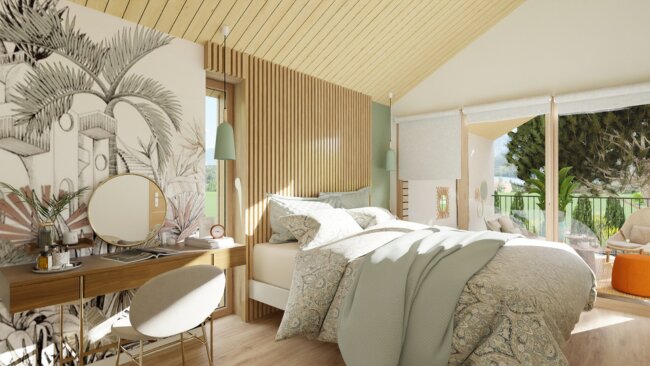
Design Explanation: Incorporating texture into bedroom design involves using a variety of materials and finishes to add depth and tactile interest. You can achieve this through a combination of textiles like rugs, throw pillows and curtains, as well as furniture and wall treatments.
Why It’s a Good Idea: Adding texture to a bedroom is beneficial for several reasons:
- Enhances Comfort: Soft, tactile materials like quilts, pillows and rugs make the room feel more comfortable and inviting.
- Creates Visual Interest: A mix of textures creates layers of visual intrigue and prevents the room from looking flat and monotonous.
Tips for Implementing in Your Design: Here are some detailed tips for adding texture to your bedroom designs:
- Textiles: Use a variety of textiles, such as quilts, throw pillows and curtains, to introduce softness and warmth.
- Furniture Finishes: Combine different furniture finishes. For example, you can create contrast with a rustic wooden dresser combined with a modern upholstered bed.
- Wall Treatments: Add depth to the walls with textured wall treatments like wallpaper, shiplap or exposed beams.
- Rugs: Layer rugs of different materials and patterns to create a cozy and visually interesting floor space.
- Decorative Accents: Use textured decorative accents like woven baskets, ceramic vases or metal lamps to add more character and detail.
But how do you know if you’ve got the right combination of textures in your design? Why not use a 3D design program like Contemporary Style Design to visualize the space with all its textures, before you start purchasing furniture and fixtures? With Contemporary Style Design, you don’t have to be a 3D design expert to get realistic visualizations of your bedroom ideas with realistic textures and lighting effects. Try Contemporary Style Design today for FREE to see how easy it is to use.
4. Hide the TV

Bedroom Idea Explanation: Hiding the TV in a bedroom design involves integrating it in a way that it doesn’t dominate the room’s aesthetic. This is especially important in a small space with a big TV. TVs are a necessary feature for some clients, but they can detract from the overall decor if not properly integrated.
Why It’s a Good Idea: Concealing the TV offers several advantages:
- Maintains Aesthetic Appeal: Hiding the TV helps keep the focus on the room’s design elements, such as artwork or architectural features.
- Creates a Restful Space: Reducing the visual presence of the TV can make the room feel more serene and conducive to relaxation.
- Increases Functionality: By hiding the TV when not in use, the room can serve multiple purposes without the TV becoming a distraction.
Tips for Implementing in Your Design: To effectively hide the TV in your bedroom designs, consider these specific tips:
- Furniture Solutions: Use an armoire or cabinet with doors to conceal the TV when it’s not in use.
- Sliding Panels: Install sliding panels or barn doors that can cover the TV and add an interesting design element to the wall.
- Mirror TV: Invest in a mirror TV. It functions as a regular mirror when the TV is off so that it blends into the decor.
- Artwork Covers: Use artwork that can be moved or slid aside to reveal the TV behind it.
- Custom Built-Ins: Design custom built-in units that incorporate the TV’s exact size in a way that it can be easily hidden or revealed as needed.
5. Mix & Match Furniture Styles
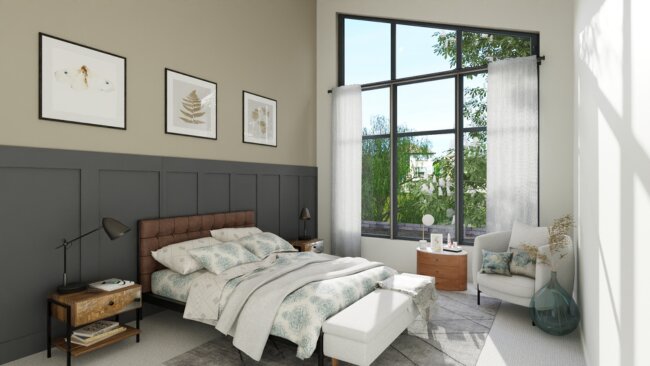
Bedroom Idea Explanation: Mixing and matching furniture styles in a bedroom involves combining pieces from different design periods and aesthetics to create a unique and personalized look. This design approach allows for creativity and flexibility, and lets you incorporate both modern and vintage elements, or blend rustic with contemporary styles. A carefully curated mix like that adds depth and character to a room while making it feel more lived-in and personalized.
Why It’s a Good Idea: Mixing and matching furniture styles offers several benefits:
- Personalization: This approach allows clients to express their unique tastes and preferences to create a bedroom that feels distinctly theirs.
- Visual Interest: Combining different styles can prevent the room from looking too uniform or monotonous.
- Flexibility: It offers flexibility in design so it’s easier to incorporate existing furniture pieces with new additions.
Tips for Implementing in Your Design: To successfully mix and match furniture styles in your bedroom designs, consider these specific tips:
- Create a Cohesive Color Palette: Use a consistent color palette to tie the different styles together.
- Balance Proportions: Mix furniture pieces that are proportionate in scale to maintain a balanced and cohesive look.
- Incorporate Common Elements: Use common elements, such as similar finishes or textures, to create a sense of unity among diverse styles.
- Statement Pieces: Choose one or two statement pieces that stand out and then build the rest of the room around them.
- Experiment with Accessories: Use accessories like throw pillows, rugs and artwork to bridge different styles and add continuity.
6. Add a Window Nook
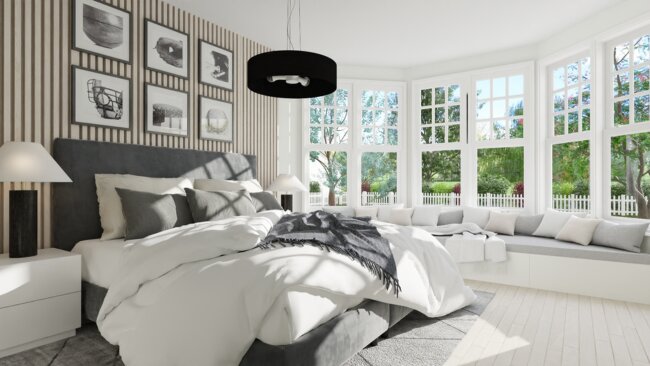
Design Explanation: Adding a window nook in a bedroom involves creating a cozy seating area near a window, often by incorporating built-in benches or comfortable chairs. Bedroom ideas like this take advantage of natural light and provide a serene spot for reading, relaxing or enjoying the view. A nook like this not only maximizes the use of available space but also adds a touch of elegance and comfort to the bedroom.
Why It’s a Good Idea: A window nook offers several advantages for your clients:
- Increases Functionality: Provides an additional seating area for reading, workin, or relaxing. This makes the bedroom more versatile.
- Enhances Natural Light: Maximizes natural light for a bright and inviting atmosphere.
- Adds Visual Interest: A beautifully designed nook can serve as a focal point in the bedroom
Tips for Implementing in Your Design: To effectively add a window nook to your bedroom designs, consider these specific tips:
- Built-In Benches: Install built-in benches with storage underneath to create a functional and space-saving seating area.
- Comfortable Chairs: Use a pair of comfortable chairs with a small side table to create a cozy nook.
- Cushions and Throw Pillows: Plush cushions and throw pillows enhance comfort and style.
- Window Treatments: Use curtains or blinds that can be easily adjusted to control light and privacy.
- Decorative Accents: Include decorative accents like a small lamp, potted plants or books to personalize the space.
7. Get Creative with Nightstands
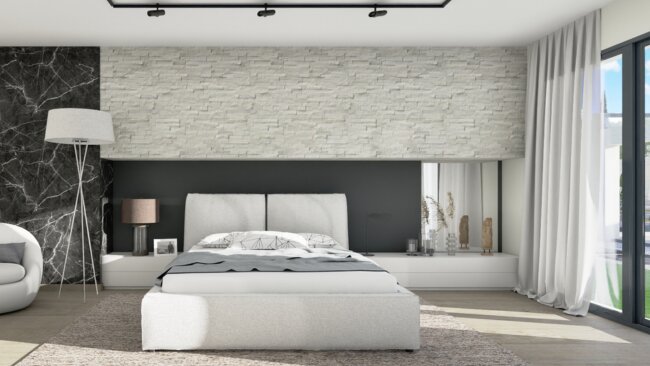
Design Explanation: Nightstands play a crucial role in bedroom design. Getting creative with bedside tables involves thinking beyond the traditional bedside table and exploring unique alternatives that add style and functionality to the bedroom. This can include using repurposed furniture, unconventional materials or even custom-designed pieces.
Why It’s a Good Idea: Creative nightstands offer several benefits for bedroom design:
- Personalizes the Space: Unique nightstand choices better reflect your client’s personality and style. This helps your client’s main bedroom feel more tailored and special.
- Maximizes Functionality: Innovative designs can provide additional storage or multifunctional uses to enhance the bedroom’s practicality.
- Adds Visual Interest: Unconventional nightstands add an extra layer of intrigue and character to the bedroom.
Tips for Implementing in Your Design: Here are a few ideas.
- Repurposed Furniture: Use repurposed items like a vintage chair, a small dresser or a stack of books as a nightstand.
- Floating Shelves: Install floating shelves next to the bed to save floor space and create a minimalist look.
- Multifunctional Pieces: Choose nightstands with built-in storage or additional features like charging stations or lighting.
- Matching and Mixing: Don’t be afraid to mix different styles on either side of the bed for a more eclectic and personalized look.
8. Add Visual Height
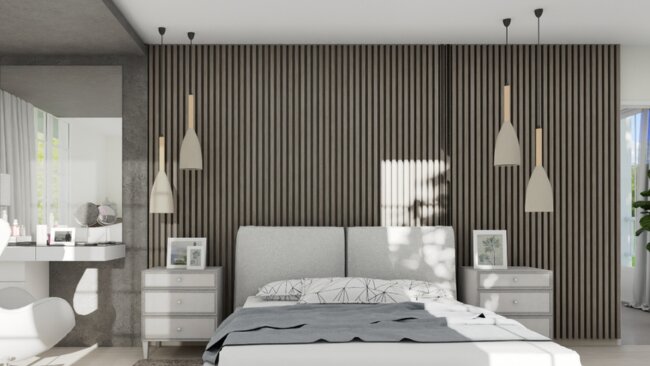
Design Explanation: Adding visual height in a bedroom design involves using various techniques to make the room appear taller and more spacious. Do this with vertical design elements such as tall headboards, floor-to-ceiling curtains or strategically placed artwork. Creating an illusion of height can make even a small space feel more open and airy.
Why It’s a Good Idea: Creating visual height in a large or small bedroom offers benefits like these:
- Makes Small Spaces Feel Larger: Adding height can make a small bedroom feel more spacious and less cramped.
- Enhances the Design: Tall elements can add drama and elegance to the room and make it look more luxurious.
- Improves Airflow and Light Distribution: Higher ceilings can improve the distribution of light and airflow so the space is more comfortable
Tips for Implementing in Your Design: To effectively add visual height to your bedroom designs, consider these specific tips:
- Tall Headboards: Choose a tall headboard to create a vertical focal point in the room.
- Floor-to-Ceiling Curtains: Use long curtains that extend from the ceiling to the floor to draw the eye upward.
- Vertical Patterns: Incorporate vertical patterns on the walls, such as stripes or paneling.
- High Shelving: Install shelves or storage units higher up on the walls to make good use of vertical space.
- Artwork Placement: Hang artwork or mirrors higher on the walls to create a sense of elevation.
9. Stylish Window Coverings
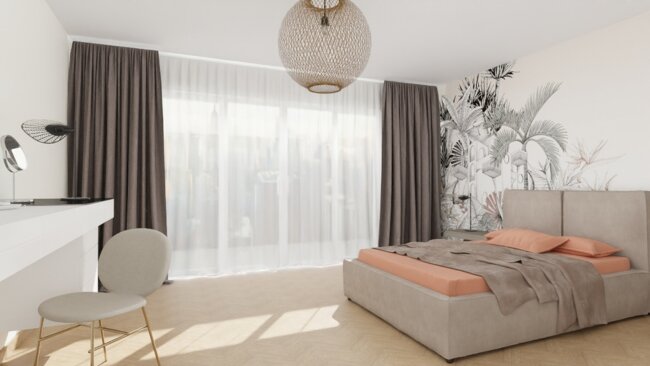
Design Explanation: Stylish window coverings can significantly enhance the aesthetic and functionality of a bedroom. This design idea involves choosing window treatments that complement the overall decor while providing necessary light control and privacy.
Why It’s a Good Idea: Implementing stylish window coverings offers several advantages:
- Enhances Decor: Window treatments can be a key design element that ties the room’s decor together.
- Controls Light and Privacy: The right window coverings allow for easily adjustable light control and privacy.
- Adds Insulation: Certain types of window coverings, like thick curtains or thermal blinds, can even improve the room’s insulation and energy efficiency.
Tips for Implementing in Your Design: To effectively use stylish window coverings in your bedrooms, consider these specific tips:
- Layering: Add depth and flexibility by using different types of window coverings, such as sheer curtains with heavier drapes.
- Color Coordination: Choose colors and patterns that complement the room’s color scheme and overall design.
- Material Selection: Select materials that suit the room’s style, such as light linens for a breezy coastal bedroom look or rich velvets for a luxurious feel.
- Custom Fit: Ensure that window coverings are custom-fitted to the windows to create a polished and professional appearance.
- Hardware: Don’t forget to pay attention to the hardware like curtain rods and tiebacks, since these add to the overall style of the window treatments.
10. Style a Seating Area
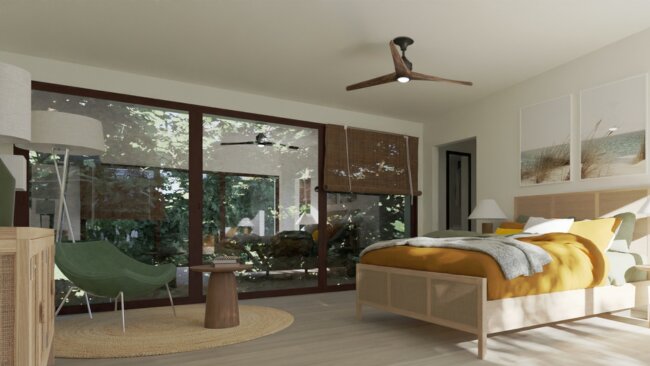
Design Explanation: Styling a seating area in a bedroom involves creating a dedicated space for relaxation and other activities, such as reading or enjoying a morning coffee. A well-designed seating area like this adds functionality and charm to any bedroom.
Why It’s a Good Idea: Creating a seating area in a bedroom offers several benefits:
- More Functionality: Provides an additional functional space within the bedroom for various activities.
- Adds Comfort: A comfortable seating area makes the bedroom more inviting and enjoyable.
- Creates Visual Interest: A well-styled seating area can serve as the bedroom’s focal point.
Tips for Implementing in Your Design: Here are some ideas for adding a seating area in your bedroom designs:
- Choose Comfortable Furniture: Select chairs or a loveseat that are both stylish and comfortable.
- Add a Side Table: Include a small side table or coffee table to hold books, drinks or decorative items.
- Incorporate Lighting: Use floor lamps or table lamps to provide adequate task and ambient lighting for reading or relaxing.
- Use Textiles: Add cushions, throw pillows and blankets to make the seating area more cozy.
- Position Near Windows: Place the seating area near a window to take advantage of natural light and views.
- Personalize with Accessories: Include personal touches such as artwork, plants or decorative items to make the seating space feel special.
Start Creating Stunning Bedroom Interior Designs Today
Whether you’re designing a primary bedroom or a small bedroom for guests, creating stunning bedroom designs that meet your clients’ needs is easier than ever with Contemporary Style Design software. Our intuitive home design design platform helps you visualize and plan every detail of your bedroom ideas.
- User-Friendly Interface: Easy-to-use tools that let you create detailed and accurate bedroom designs.
- 3D Visualizations: Bring your designs to life with high-quality 3D renderings that impress clients and make it easier for them to visualize the final result.
- Large Design Library: Access a wide range of design elements, including customizable furniture, textures, and lighting options.
- Collaboration Tools: Easily share designs with clients and collaborate in real-time with your team to quickly make adjustments based on feedback.
Start using Contemporary Style Design today to see how it can streamline your design process and help you land more clients!




